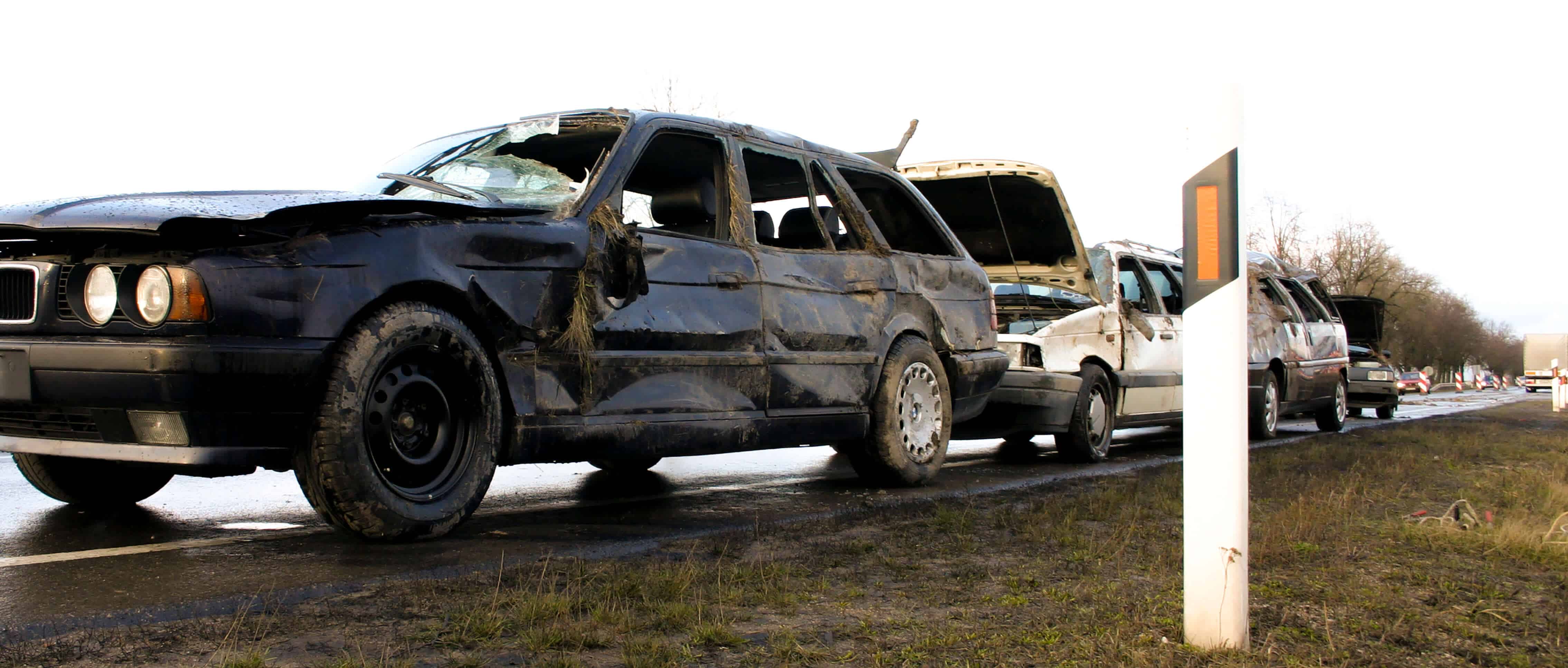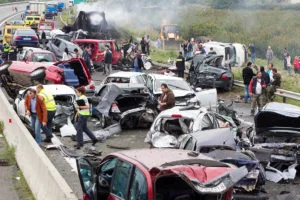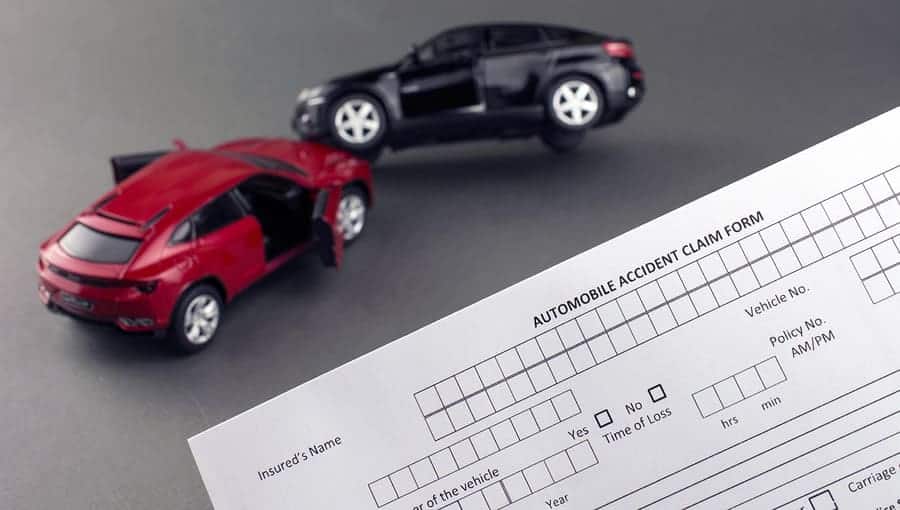Multi Vehicle Accident Settlement | Multiple Car Accident Settlements

Types of Multi Car Accidents
Some of the most common accidents that lead to multiple claims are as follows:
- Vehicle rear ends another on a busy highway. It is then rear ended by another vehicle. This causes several rear end crashes.
- Two vehicles slam into each other on a busy road. One of them flies into oncoming traffic. This causes drivers to hit each other to avoid a crash.
- Driver changes lanes too fast on the interstate. This leads to other drivers stopping and swerving, leading to several accidents.
Multi-Vehicle Accident Settlements
Multiple vehicle accidents can be terrifying. There are several vehicles involved that can become dangerous, 4,000 lb. missiles that can 
Such multiple car accidents may be more complex because there potentially are several plaintiffs, defendants and auto insurance companies involved. If you are a victim of a multi vehicle accident, it is vital to retain an experienced personal injury attorney. This article describes the complexities involved in multiple vehicle accidents, claims information, and related legal considerations.

- How Much Is Your Car Accident Settlement Worth?
Find out the maximum compensation you could receive.
- How Much Is My Car Accident Settlement Worth?
Overview of Multi Vehicle Crashes
Multi car accidents make up approximately 15% of all auto deaths in the US, and comprise nearly 13,000 injuries per year.
Crashes that involve several vehicles contain multiple dangers; there can be both primary and secondary points of impact. The primary impact happens when the negligent driver smashes into another vehicle. The secondary impact happens when other drivers try to avoid a crash. They often end up hitting one another. When there is a risk of primary and secondary impacts, the chance of serious personal injury and death rises.
Types of Multi Car Accidents
Some of the most common accidents that lead to multiple claims are as follows:
- Vehicle rear ends another on a busy highway. It is then rear ended by another vehicle. This causes several rear end crashes.
- Two vehicles slam into each other on a busy road. One of them flies into oncoming traffic. This causes drivers to hit each other to avoid a crash.
- Driver changes lanes too fast on the interstate. This leads to other drivers stopping and swerving, leading to several accidents.

- Speak to a Car Accident Attorney
- Fast, Free & Confidential!
Establishing Liability in Multiple Car Accidents
The most important issue in such accidents is establishing who was liable or negligent in the accident. All injured parties have a right to compensation from the negligent driver or drivers.
But with so many vehicles involved, determining liability can be difficult. There are some cases where the driver admits liability, such as being the first driver to rear end another car. Liability in that case is clear.
But there are often many other factors involved in these complicated accidents that can lead to more than one person being liable:
- Bad weather: A common cause of multi car accidents is poor visibility due to rain or fog. Slick roads can be a major factor as well.
- Speeding: Driving too fast has always been a cause of crashes, and several drivers could be speeding, leading to a very bad pile up. Driving at high speed will exaggerate the impact of minor driving errors and can lead to very serious injuries.
- Driver fatigue: Falling asleep for just a second can cause a car to drift and hit several other vehicles.
- DUI: There are thousands of deaths due to drunk driving every year, and many thousands more injuries. Drunk driving causes multiple car accidents every day.
- Texting and driving: Many multi-vehicle accidents are caused by cell phone use behind the wheel.
If there are several parties that could have been negligent in the accident, a personal injury attorney must typically get involved on your behalf. It can take a long accident investigation to determine who may be liable and whose insurance policies should pay what to whom.
When an accident with several vehicles occurs, investigators are brought in to investigate the car accident claims and accident scene. The investigators will work to find the root cause of the crash. This is always a complicated process. To determine which driver or drivers are at fault, investigators usually will do the following:
- Look at police reports: When police respond to the scene, they will write a police report that may state an opinion on the cause of the crash.
- Talk to police officers and other investigators to get a better idea of liability
- Determine if any of these matters were involved with any drivers: warrants outstanding; DUI; open containers; illegal drug possession; suspended license; speeding; lack of auto insurance; aggressive driving as noted by witnesses; cell phone use and/or distracted driving.
- Interview all drivers, passengers and accident witnesses
- Take photographs of the scene of the accident as well as vehicles and any damages
- Look at all drivers’ records to determine if there is a history of unsafe vehicle operation
The insurance company investigators may try to show evidence that their client did not cause your injuries and/or property damage. Your attorney may counter by showing evidence that his investigative team uncovered. Generally, insurance companies will fold quickly and settle when they are shown strong evidence that their driver was at least partially liable for the accident.
Many insurance companies will settle once they understand that the plaintiff is represented by an effective personal injury attorney. They do so because they know that going to court costs even more. Also, juries are notoriously unpredictable. The insurance company could end up with a much larger financial loss – plus the additional negative publicity that comes with a big dollar verdict.
Multi-Vehicle Accident Settlement Calculator:
Have you been injured in a multiple vehicle accident? Find out how much financial compensation you may be legally entitled to in just minutes with our free online Multi Vehicle Accident Settlement Calculator.
Legal Issues in Multiple Car Accidents
There can be several legal issues to address in a car accident with several vehicles involved. If you have been injured in such an accident, during your attorney’s investigation, he will also try to determine if more than one person can be blamed for your injuries. The more drivers who can be blamed for the accident, the better for you.
This may seem cynical on one level, but there is a good reason to seek as many legitimately responsible parties as possible. Many crashes with several vehicles are high speed and chain reaction events. Many people may be seriously hurt or dead. If only one driver is found negligent, this may mean that there is a relatively limited amount of insurance funds available to pay for the injuries of several plaintiffs.
For this reason, the personal injury attorney you hire will conduct a thorough investigation to determine if there is more than one responsible driver for the accident. An aggressive personal injury attorney will look for available insurance policies to tap for compensation wherever possible. The attorney also may issue requests for admission against every other party. They may even begin to attack the case for other plaintiffs. This may involve filing a motion for a summary judgment on crash liability. The attorney may get aggressive on forcing other plaintiff’s attorneys to file court documents on time.
A show of force in a car accident involving several plaintiffs can be important for you, especially if you have severe injuries. You could have injuries that require months or years of rehab, and could cost you hundreds of thousands of dollars. A good personal injury attorney will try to put you in a place where you get paid as much as possible – and even overpaid. The job of your attorney is to get you as much compensation as possible for your injuries.
We bring up these unpleasant legal issues to stress the fact that you should hire the best, most experienced personal injury attorney possible in a multi vehicle crash – if you want to get full compensation for your accident injuries.
Many of these car accidents lead to lawsuits, unfortunately, because auto insurance companies often deny claims, refusing to compensate their client or other drivers. This is the point where working with insurance companies in crashes with several drivers can get very challenging. But your aggressive and experienced personal injury attorney can help you to get through this process and be fairly compensated.
Another major legal issue in such accidents is the contributory negligence statutes that some states have, such as Virginia. This means that if you were even 1% responsible for any part of the crash, you may not receive compensation for your injuries. This may seem unfair, but this is the law in many states, including Alabama, Maryland, Virginia and North Carolina.
At least 33 states have a comparative negligence standard. This means that the amount of compensation you may receive for your injuries can be reduced by your percentage of fault for the incident. There are two types of comparative negligence laws, depending upon the state:
- 50% rule: A driver with injuries who is found to have fewer than 50% liability for the accident can seek compensation from the liable drivers.
- 51% rule: The injured driver may seek compensation for his injuries if he is 50% or less responsible for the accident.
Consult an Attorney Experienced in Multi Vehicle Wrecks
This page should drive home the point that crashes involving several drivers and vehicles are complicated. There can be many people with serious and even fatal injuries. The pool of available insurance funds may be limited. So as soon as possible after the accident, get a referral for an experienced personal injury attorney in multiple vehicle crashes.
Frequently Asked Questions:
Multi Vehicle Accident Settlements
After a multi-vehicle car accident, some period of time needs to go by before you understand the severity and nature of your injuries. Even minor pain and injuries could linger for a few weeks after an auto accident involving multiple care before you can completely assess how it affects your life. More serious car accident injuries will necessitate medical treatment that may be ongoing for weeks or months, and the fact that there were multiple cars involved in the accident just complicated things further… more injuries, more cars to fix, and more insurance companies to negotiate with.
But there is a time limit you have to file a car accident claim for your multi vehicle accident, knows as the statute of limitations. The statute of limitations is defined as the maximum amount of time someone has to file for legal recourse (file a claim or initiate a car accident lawsuit) after the incident occurred.
Most states have a statute of limitations of 2-3 years for car accidents, although there are a few exceptions. This doesn’t mean that you have to agree to accept an auto accident settlement in this time frame, just that you need to initiate the process. Getting your case started is one thing, but you do not want it resolved (i.e. accepting a multi vehicle settlement offer) before you understand the full nature and extent of your injuries.
Once you have filed a car accident claim with the insurance company asking for compensation for your injuries, lost work time, and pain and suffering, you will start negotiating the final multi vehicle accident settlement.
An important aspect of the negotiation process is whether you have reached maximum medical improvement, or MMI. This means you are as healthy as you will be after your injuries, or you and your lawyer at least know how to assign a value to your damages as far as future medical treatments and the ongoing financial costs of your injuries.
Keep in mind there is nothing lost by starting the car accident claims process before you reach your MMI. Just be sure you fully understand what your past and future damages are before you settle the case.
You need to make sure you do not accept a multi vehicle car accident settlement and sign a liability waiver before you are confident you have reached MMI, or you have fully accounted for the necessary expenses for your future care in the settlement. Once you have signed the waiver, the case is settled and there is no going back.
Determining who is at fault in chain reaction car accidents can be challenging. The more cars involved, the more complex the investigation.
When the accident happens, the police will do an investigation to determine the cause of the crash and who might be at fault. But remember: Police can issue tickets for traffic violations, but they do not determine who is liable for an accident.
Because of the amount of insurance money involved when there are several vehicles involved in a chain reaction wreck, it is common for auto insurance companies to bring in their own investigators to determine fault.
The legal system determines who is at fault by finding the person who started the chain reaction crash. In a rear end crash, it is assumed to be the driver at the back of the accident.
Investigators for the insurance companies will also look at other possible contributing factors:
- Was distracted driving a factor?
- Were any drivers under the influence of alcohol?
- Was any driver speeding or engaging in road rage?
- Were any drivers tailgating?
- Was any driver driving the vehicle too fast for weather conditions?
In a chain reaction crash, it is important to have a skilled personal injury attorney advocating on your behalf. He will maximize the chance that you will get as much compensation as possible for your injuries in this complex crash claim or lawsuit.
In a multi-car accident, it is rare for the front vehicle to be blamed for the accident. However, it can occur on occasion. Witnesses or others involved I the crash may say that the front car stopped for no reason – no traffic light, traffic or stop sign – just stopped for no reason at all. Or, the front vehicle may have suddenly moved from one lane into another and hit their brakes. In these cases, it is possible for the front driver to be at fault, but again, this is rare.
The average car accident settlement ranges between $14,000 and $28,000, so generally, the typical settlement average is $21,000. The average for a more serious car accident is $31,000. You should talk to your personal injury attorney to find out more information about what the settlement amount could be for the front driver in a multi-car accident.
When you are in an accident that involves several cars, establishing fault is complicated. There are usually several auto insurance companies involved and all are trying to reduce their liability and pass the buck to the next person and company. This means there will probably be multiple parties to blame for different parts of the accident. So, you will want to hire an experienced multi-car accident personal injury attorney who has the experience and skills to handle these complex cases.
An attorney who is skilled in multi-car accidents will be able to handle the following aspects of your case:
- Find and communicate effectively with all insurance companies involved
- Determine the level of insurance coverage for each driver
- Determine degree of fault for each driver
- Whether you share any blame for the accident, and whether you have a case
- Gather all needed information by completing a thorough investigation, research and deposing witnesses
- Ensure medical bills are being paid by insurance companies
- Get you a fair settlement for lost wages, pain and suffering and and injuries
Chain reaction crashes are very dangerous and scary, as there is more than one threat to your safety. These cases are more complicated for attorneys to work out for settlement because there are several defendants and insurance companies involved.
The largest issue in a multi-vehicle accident is to determine who was at fault. The dollar value for a multi-vehicle accident can run high. So, an insurance company may bring in a special investigator to review the accident case. The matter of fault is going to hinge on duty of care and proximate cause.
Every driver has what is known as duty of car to drive in a safe and reasonable way and to watch out for others on the road. If a driver or drivers breaches their duty of care, there must be a connection made between the breach and the accident.
The most difficult part of an auto insurance claim with several cars and drivers is that it is challenging to assign blame equally and fairly among all drivers. Disputes may arise. Keep in mind that in most multi-car accidents, there will be multiple claims for compensation, they will probably be contested and the entire process will take longer. You will almost certainly need a personal injury attorney in such cases to best represent you. It is best to present your case to your attorney in a consultation to get a better idea of what the claim could be worth.
Typically, the driver that has rear-ended you is liable for any damages that occur to any of the vehicles involved in the multi car accident.
However, this does not mean that the last car involved is always liable for the entire accident. Generally, it is the responsibility of each driver to control their vehicle and keep distance to avoid a rear-end collision in the event of any sudden stops. If the police report and/or witness statements show that you were following too closely behind the car in front of you, there’s a chance partial fault may lie with the middle car as well.
Generally, 3-car pile-ups are rear-end collisions possibly causing a chain reaction of accidents, typically determining the rear car at-fault for the entire pile-up. However, it’s not always the rear driver’s fault. If you are the last car to be involved in a 3-car pile-up it ordinarily means there was some reason, which caused the 2 cars ahead to collide such as bad weather, or the first car failed to have proper break lights. Determining who is at-fault in a 3-car pile-up is a complex process that involves investigating each driver’s circumstances. Just because you are the last car involved in a multi-vehicle accident does not necessarily mean you will be determined at-fault. Be sure to collect concrete evidence such as a police report, eyewitness statements and interviews from other drivers/passengers.
In the unfortunate event that you are involved in a multi-vehicle accident involving 3 or more cars, it can be a bit confusing exactly who to put the blame on. A vehicle may hit another vehicle since they themselves were affected from behind, which usually happens in multi-vehicle collisions. So, how do you determine who is liable for a multi-vehicle accident? When one driver runs into the back of another, and that individual’s car is involuntarily forced forward into the car before them, that driver would be at-fault since they solely began the chain reaction. The driver determined to be at-fault for the accident is liable for damages to property as well as personal injuries. The liable party is responsible to pay either out of pocket or through their insurance.
What does it mean to be involved in a “chain reaction” car accident? A chain reaction car accident involves at least 3 vehicles where one vehicle hits another in a progression of backside collisions that are caused by the impact of the primary crash. For example, it’s a rainy day and the road is slippery. Vehicle A, rear-ends vehicle B, forcing vehicle B to rear-end vehicle C. These types of accidents can be tricky when determining who is the at-fault party is due to the amount of drivers involved in the accident. In most situations where the driver rear-ends the car in front of them is liable. When determining who is at-fault you must review a series of questions for all drivers involved. Questions to help determine who is at-fault include:
- Was Driver A following Driver B at an unsafe speed or distance?
- Was Driver B following Driver C at an unsafe speed or distance stopping suddenly forcing Driver A to rear-end Driver B?
- Were any drivers driving negligently? (Under the influence, tired, distracted)
- Were there any eyewitnesses to verify?
- Break lights and signals working properly
- Debris in the road that has failed to be cleared causing sudden stops
- Evidence from vehicle damage can help determine who is at-fault

- What’s my car accident settlement worth?
- Find out in less than 60 Seconds!
Related Articles
Whiplash Payout Scale for Grades 0-4
Whiplash is common in car accidents, especially rear-end collisions. Your head and neck are forcefully jerked back and forward by the rapid acceleration-deceleration combination, causing injury to the head, neck, and shoulders. Each auto accident is...
How Long Does a Car Accident Settlement Take?
Involvement in a traffic collision creates a difficult situation, which can be made worse by injuries and property damage. You may be legally entitled to monetary compensation. How long does a car accident settlement take? The answer is different for everyone, but...
How To Adjust to the Traffic and Transportation Culture of a New Area
Even within the same country, transportation cultures can be drastically different. For instance, in New York, the public transportation system is a lifeline for many residents, with the subway being the primary mode of transportation. The city's layout encourages...
The Safety, Pros, and Cons of Different Methods of Transit
There are pros and cons for the different forms of transportation people use every day. The choice of how to get to work or school, run errands, or take longer trips often depends on what modes are available. In densely populated cities, bikes, walking, and public...
How Smart Infrastructure Will Improve and Complicate Public Safety
The American Society of Civil Engineers explains that smart infrastructure uses sensors, cameras, and other connected devices to collect information that helps provide better public services. It works in security, traffic, public transportation, utilities, air...
How To Rethink Your Approach to Hobbies in Light of an Injury
Hobbies are incredibly important for your health and your quality of life. They reduce your stress levels and fight off anxiety and depression by allowing your brain to focus on something you enjoy. You can use hobbies to connect with others, get outside, and get...
Can Exercising Negatively Affect a Car Accident Settlement?
Exercise is a daily part of life for many people. Some individuals work out to stay fit and improve their mobility while others enjoy the mental health benefits of running, swimming, and participating in other forms of exercise. However, after a car accident, it can...
How To Identify Dangerous Driver Behavior in a Taxi or Rideshare
You’ve most likely taken a taxi or rideshare from or to the airport, an event, or just to a friend's house. As integral tools in modern life, they offer convenience, efficiency, and, in many cases, a cost-effective alternative to owning a car. However, like any other...
How New Technologies May Pose New and Unique Distracted Driving Challenges
Distracted driving is one of the most common causes of accidents. The National Highway Transportation Safety Administration (NHTSA) counted 3,522 fatalities in 2021 due to distracted driving. Distracted driving is usually associated with cell phones, but the Centers...
